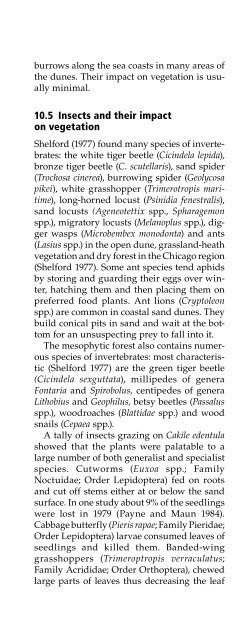The Biology of Coastal Sand Dunes M. Anwar Maun - Inecol
The Biology of Coastal Sand Dunes M. Anwar Maun - Inecol
The Biology of Coastal Sand Dunes M. Anwar Maun - Inecol
You also want an ePaper? Increase the reach of your titles
YUMPU automatically turns print PDFs into web optimized ePapers that Google loves.
urrows along the sea coasts in many areas <strong>of</strong><br />
the dunes. <strong>The</strong>ir impact on vegetation is usually<br />
minimal.<br />
10.5 Insects and their impact<br />
on vegetation<br />
Shelford (1977) found many species <strong>of</strong> invertebrates:<br />
the white tiger beetle (Cicindela lepida),<br />
bronze tiger beetle (C. scutellaris), sand spider<br />
(Trochosa cinerea), burrowing spider (Geolycosa<br />
pikei), white grasshopper (Trimerotropis maritime),<br />
long-horned locust (Psinidia fenestralis),<br />
sand locusts (Ageneotettix spp., Spharagemon<br />
spp.), migratory locusts (Melanoplus spp.), digger<br />
wasps (Microbembex monodonta) and ants<br />
(Lasius spp.) in the open dune, grassland-heath<br />
vegetation and dry forest in the Chicago region<br />
(Shelford 1977). Some ant species tend aphids<br />
by storing and guarding their eggs over winter,<br />
hatching them and then placing them on<br />
preferred food plants. Ant lions (Cryptoleon<br />
spp.) are common in coastal sand dunes. <strong>The</strong>y<br />
build conical pits in sand and wait at the bottom<br />
for an unsuspecting prey to fall into it.<br />
<strong>The</strong> mesophytic forest also contains numerous<br />
species <strong>of</strong> invertebrates: most characteristic<br />
(Shelford 1977) are the green tiger beetle<br />
(Cicindela sexguttata), millipedes <strong>of</strong> genera<br />
Fontaria and Spirobolus, centipedes <strong>of</strong> genera<br />
Lithobius and Geophilus, betsy beetles (Passalus<br />
spp.), woodroaches (Blattidae spp.) and wood<br />
snails (Cepaea spp.).<br />
A tally <strong>of</strong> insects grazing on Cakile edentula<br />
showed that the plants were palatable to a<br />
large number <strong>of</strong> both generalist and specialist<br />
species. Cutworms (Euxoa spp.; Family<br />
Noctuidae; Order Lepidoptera) fed on roots<br />
and cut <strong>of</strong>f stems either at or below the sand<br />
surface. In one study about 9% <strong>of</strong> the seedlings<br />
were lost in 1979 (Payne and <strong>Maun</strong> 1984).<br />
Cabbage butterfly (Pieris rapae; Family Pieridae;<br />
Order Lepidoptera) larvae consumed leaves <strong>of</strong><br />
seedlings and killed them. Banded-wing<br />
grasshoppers (Trimeroptropis verraculatus;<br />
Family Acrididae; Order Orthoptera), chewed<br />
large parts <strong>of</strong> leaves thus decreasing the leaf<br />
ANIMAL–PLANT INTERACTIONS 157<br />
area and photosynthesis. Flea beetles<br />
(Phyllotreta cruciferae and P. striolata; Family<br />
Chrysomelidae; Order Coleoptera) were also<br />
very serious pests <strong>of</strong> this species. <strong>The</strong> insects<br />
rasped small pits in the foliage, chlorophyll<br />
was lost and seedlings died. <strong>The</strong> diamondback<br />
moth (Acrolepia xylostella; Family<br />
Plutellidae; Order Lepidoptera) caused minor<br />
damage by eating from the underside <strong>of</strong> leaves<br />
and producing many small holes. Snout beetles<br />
(Hypera postica and H. nigrirostris) were<br />
particularly abundant on cold windy days and<br />
fed on cotyledons <strong>of</strong> young seedlings in early<br />
spring. Aphids (Hyadaphis erysimis; Family<br />
Aphididae; Order Homoptera) infested about<br />
37% <strong>of</strong> Cakile plants on the beach in July <strong>of</strong><br />
each year and caused curling <strong>of</strong> leaves and<br />
stunting <strong>of</strong> stems. Ladybird beetles did exert<br />
some control on aphid populations but their<br />
numbers were small.<br />
Many insects have been reported to damage<br />
Ammophila breviligulata (<strong>Maun</strong> and Baye<br />
1989). Aphids infected the apical meristems<br />
and a beetle (Strigoderma arboricola) entered<br />
the open florets and consumed both the male<br />
and female parts <strong>of</strong> the flower and developing<br />
seeds. A s<strong>of</strong>t scale insect (Eriococcus caroliniae),<br />
was a serious pest that consumed<br />
leaves and sheaths <strong>of</strong> plants. Caterpillars <strong>of</strong><br />
the family Danaidae consumed all parts <strong>of</strong><br />
A. breviligulata including the glumes, lemma<br />
and palea. Other insects <strong>of</strong> minor importance<br />
consisted <strong>of</strong> a gall midge (Mayetiola ammophilae),<br />
a moth (Chenoriodes arenella), a bug<br />
(Phyllophaga rugosa), banded-wing grasshopper<br />
(T. verraculatus) and nematodes. In<br />
Lithospermum caroliniense the insect damage<br />
was primarily caused by larvae <strong>of</strong> Ethmia<br />
longimaculella that constructed webs around<br />
the cymes <strong>of</strong> stems and consumed leaves and<br />
flowers inside the webs (Westelaken and<br />
<strong>Maun</strong> 1985a). Approximately 8–17% <strong>of</strong> the<br />
flowers per plant on the first dune ridge at the<br />
Pinery were consumed. Tent caterpillars<br />
(Malacosoma americanum) are a common sight<br />
on Prunus virginiana in spring <strong>of</strong> each year<br />
and may completely defoliate shrubs.

















